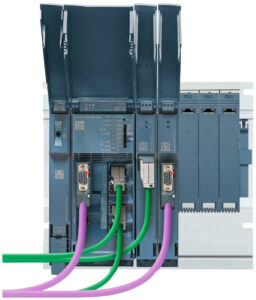The automation of process plants has been characterized by IT silos for a long time. The high level of IT security requested was achieved through strict isolation from the outside world. However, unlocking the opportunities of digitalization is thus hardly possible. In addition, openness and mobile system access are taken for granted by today’s new generation of highly skilled specialists working in future-proof plants.
Companies choosing a new control system today want to benefit from the networking of plants and knowledge worldwide. In fact, with their purchasing decision, they set the course for decades to come – and a plant’s entire lifecycle. This is a compelling reason to opt for Simatic PCS neo – Siemens’s completely web-based process control system with state-of-the-art IT security concepts. Via various end device types, innovative web technology provides convenient and secure access to all the information required – worldwide and independent of the user’s location. This considerably facilitates collaboration, especially during the engineering phase.
The first early adopter projects started after the market launch. They turned out to be of great help in developing the system further in line with customer requirements. In close cooperation with the specialists from Merck and based on the MTP standard, Siemens is testing a so-called technical backbone for modular production plants. As the POL (Process Orchestration Layer), Simatic PCS neo takes on the task of orchestration. Evonik Industries is also one of the first operators: The company is using the process control system to modernize its 40-year-old technology center (“Technikum”) at the Wolfgang Industry Park in Hanau, Germany. The process control system’s excellent scalability is a key criterion here. System integrators such as AG Solution have also demonstrated the system’s market maturity when installing it on behalf of a pharmaceutical company. AG Solution has specially mentioned simplified global collaboration as well as object-oriented, centralized data management.
Location-independent control with minimal installation effort
The new Simatic PCS neo Version 4.0 addresses all the different areas of the process industries. It fully supports the Module Type Package (MTP) standard and follows the trend toward modular plants. Intelligent process modules can thus be integrated into the control system without any further engineering effort. But the plant team benefits throughout a plant’s entire lifetime. No matter whether small applications later become world-scale plants with far more than 100,000 I/Os or whether new technologies must be integrated into a plant with minimal effort and risk: cost-efficient operation is ensured without additional complexity.
Thanks to the so-called “zero installation client”, it is not necessary to install Simatic PCS neo components on the operating computers; installation on the central server is sufficient. Control system administration sustainably benefits from the web-based architecture. Software updating and maintenance are thus reduced to a small number of servers. All maintenance activities (system software updates, integration of new PC hardware, management of security certificates, etcetera) can be performed centrally via a user-friendly administration console (AC).
Further users can be granted access at any time without an additional installation step. To clarify any questions in a sub-process, the plant team can send an access link to a specialist who is not on site. Thus, the specialist is granted controlled, time-restricted access to the corresponding system parts.
Simatic PCS neo can also be used on mobile end devices independent of the location. Maintenance and plant support personnel can thus access all the control system functions, also during a deployment in the field. Local operator workstations can be implemented by means of tablets or on-site control units.
 The Device Type Editor is another innovation implemented in Version 4.0. Field devices can be integrated in no time at all – guided graphically and without system programming. And thanks to the separation of system, library and user application layers, any device type created even continues to be valid in the case of modifications to the software system. No additional test steps, for example for an upgrade, are required.
The Device Type Editor is another innovation implemented in Version 4.0. Field devices can be integrated in no time at all – guided graphically and without system programming. And thanks to the separation of system, library and user application layers, any device type created even continues to be valid in the case of modifications to the software system. No additional test steps, for example for an upgrade, are required.
Integrated security in all dimensions
A holistic approach based on a multi-state defense-in-depth strategy provides for cybersecurity. In addition to plant security, it focuses on system integrity and network security – through secure pre-configuration (Security by Default) at the time of installation. Consistent, certificate-based communication provides for the tamper-proof connection of all users to the Simatic PCS neo servers. When it comes to security, the benefits of the web-based approach become particularly apparent. The symbiosis of IT technology and proven automation functions provides for the robustness and flexibility required to implement continuously changing security requirements within a short time. Security threats from the IT world are eliminated with the mechanisms of that same IT world. For both engineering and process control, secure access to all the control system functions is ensured at all times via modern role and rights management.
Seamless transition from Simatic PCS 7 to Simatic PCS neo
Simatic PCS neo perfectly suits the requirements of almost all industrial sectors: the chemical, pharmaceutical, water & wastewater, food and beverage, as well as the petrochemical industries. In the sugar industry, the dedicated NAHMAT automation library is now making engineering and monitoring more efficient.
In addition to Simatic PCS neo, the established Simatic PCS 7 process control system with thousands of installations worldwide also offers a future-proof solution. The two control systems reside on the same hardware platform and use a consistent configuration architecture. In the future, Simatic PCS 7 projects can thus be transferred to Simatic PCS neo with little effort.
New controller generation available
On the hardware side, new products complement the control system portfolio. Plant operators can benefit from the new generation of Simatic S7-4100 controllers. It includes a CPU specifically developed for Simatic PCS neo, the heart of the new control system.
Its predecessor, the Simatic S7-400 with the CPU 410, was already considered to be the most powerful controller available on the market for the process industries. The Simatic S7-4100 represents a consistent further development. The chip sets for core functionalities are still designed by Siemens itself. Siemens thus maintains control over the products and basic components. This means that the technology is optimally adapted to the requirements – while at the same time providing optimal protection in terms of the security-relevant hardening and availability of the chip sets. Those who rely on this new controller generation today can rest assured that it will be kept up to date over many decades. Operators thus also benefit from the continuity and innovation of hardware components over their plants’ entire lifecycle.
Like the controller available so far, the new version also features a modular design, but is much more compact. The system-internal communication of the Simatic S7-4100 is based on robust, latest-generation technology. This improves communication capabilities and enables up to five additional Profibus/Profinet CPs (communication modules). Power consumption is 50 percent lower compared to the predecessor module, with performance capability increasing. In addition, the ambient temperature range was extended and now lies between ‑25 centigrade and 70 centigrade. Thanks to internally buffered data backup, backup batteries as protection against power failure are now a thing of the past.
Scalability could also be significantly increased: Simatic PCS neo V4.0, with the Simatic S7-4100 and CPU 410 controllers, covers small- to large-scale applications consisting of 56 controllers. Since Simatic S7-4100 is functionally compatible with the current CPU 410, which will continue to be available for many years to come, an existing application can be transferred without any problem.
Communication gateway to ensure maximum connectivity
Siemens is introducing the fully integrated Simatic CN 4100 communication gateway parallel to its Simatic PCS neo V4.0. It suits the requirements of both control systems, significantly simplifying communication via Modbus TCP and OPC UA (further standards to follow soon). This enables the powerful, redundant integration of devices without a Profibus/Profinet interface, such as intelligent measurement devices, motor controllers, or entire package units.
The gateway relieves the workload of the controller and, as an element of the defense-in-depth strategy, it prevents potential attack paths leading toward it. This is a major reason why Siemens has decided to separate the device communication from the process automation via the controller. In particular, the communication gateway decouples the connection between automation systems characterized by long lifecycles and web-based systems with significantly shorter lifecycles, such as OPC UA-PC systems. Simatic CN 4100 thus significantly contributes to maintaining the innovative capability of plants in operation for many decades.
The bottom line: high innovative power throughout the lifecycle
The Simatic PCS neo process control system and the new, future-proof Simatic S7-4100 controller, as well as the Simatic CN 4100 communication gateway provide operators with all they need to commission or modernize process plants today and remain uncompromisingly competitive throughout the plant lifecycle. Siemens thus creates the basis for the future-proof automation of process plants while maintaining a company’s innovative capability across the usually long lifecycles of its plants. In addition to its remarkable performance, the new control system ensures outstanding flexibility and openness thanks to innovative hardware components while at the same time supporting significantly enhanced security concepts.



















